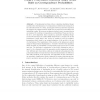Free Online Productivity Tools
i2Speak
i2Symbol
i2OCR
iTex2Img
iWeb2Print
iWeb2Shot
i2Type
iPdf2Split
iPdf2Merge
i2Bopomofo
i2Arabic
i2Style
i2Image
i2PDF
iLatex2Rtf
Sci2ools
118
click to vote
MICCAI
2007
Springer
2007
Springer
Shape Analysis Using a Point-Based Statistical Shape Model Built on Correspondence Probabilities
A fundamental problem when computing statistical shape models is the determination of correspondences between the instances of the associated data set. Often, homologies between points that represent the surfaces are assumed which might lead to imprecise mean shape and variability results. We propose an approach where exact correspondences are replaced by evolving correspondence probabilities. These are the basis for a novel algorithm that computes a generative statistical shape model. We developed an unified MAP framework to compute the model parameters ('mean shape' and 'modes of variation') and the nuisance parameters which leads to an optimal adaption of the model to the set of observations. The registration of the model on the instances is solved using the Expectation Maximization - Iterative Closest Point algorithm which is based on probabilistic correspondences and proved to be robust and fast. The alternated optimization of the MAP explanation with respect t...
Generative Model Parameters | Mean Shape | Medical Imaging | MICCAI 2007 | Statistical Shape Model |
Related Content
| Added | 14 Nov 2009 |
| Updated | 14 Nov 2009 |
| Type | Conference |
| Year | 2007 |
| Where | MICCAI |
| Authors | Heike Hufnagel, Xavier Pennec, Jan Ehrhardt, Heinz Handels, Nicholas Ayache |
Comments (0)

